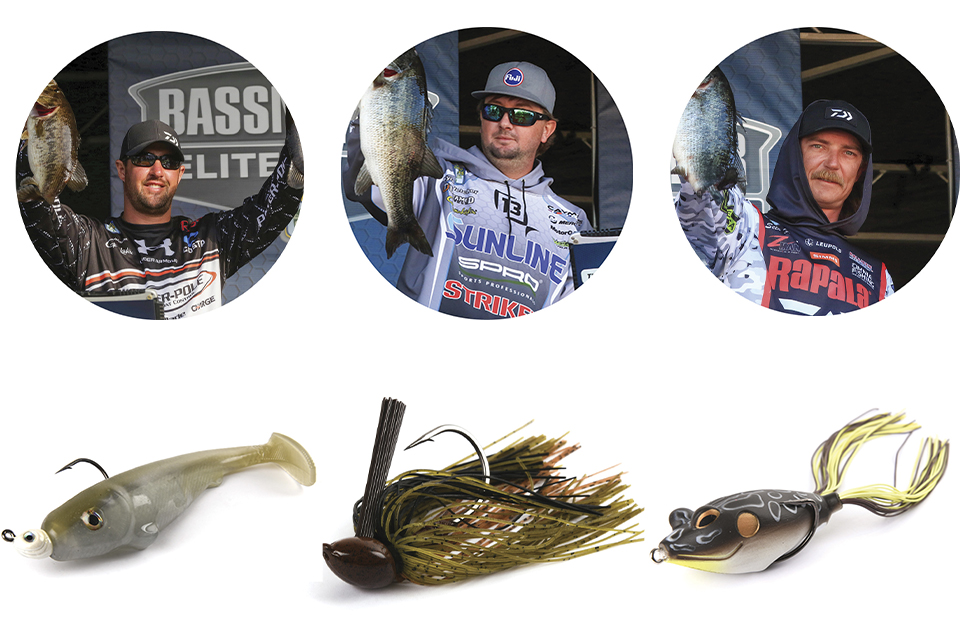
Transitioning through the year’s midpoint, bass are settling into their summer patterns. Five Bassmaster Elite Series anglers shared their insights into how they track down and engage June giants.
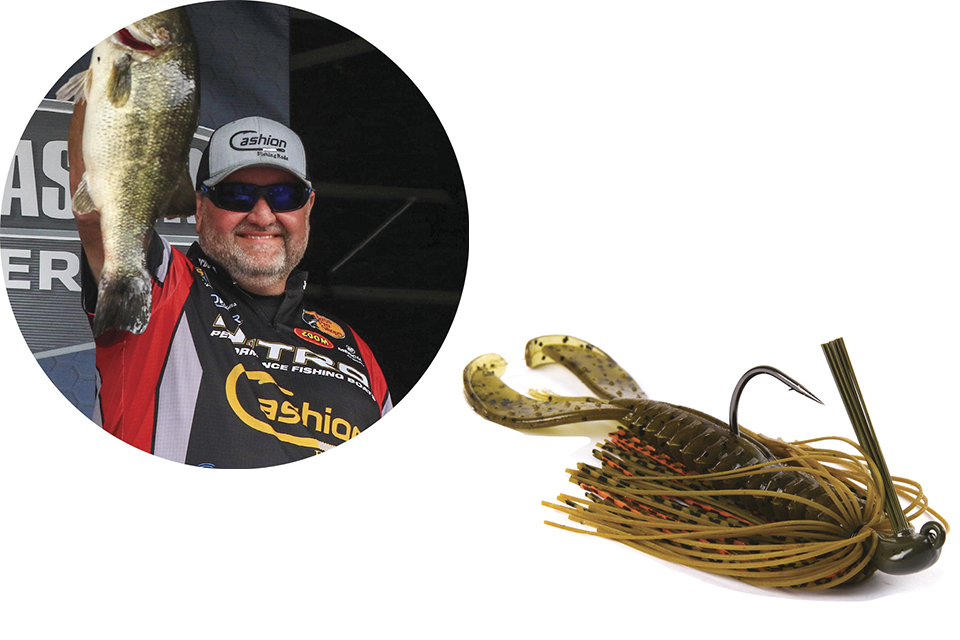
WHY: Weedless
WHERE: Brushy dock
David Williams – Southern Dock Lake
Suffice it to say this North Carolina pro knows his way around boat docks. But when he needs a big bite, Williams is very picky about the ones he targets. For clarity, he’s not terribly concerned about size, layout, etc. — it’s the unseen factors that set the stage for giant potential.
In a word: brush.
“This time of year, I’m going to target docks with deeper brush in 8 to 15 feet,” Williams said. “I like a dock that looks like someone has been fishing there — the ones with the lights or the rod holders — because the owners have probably planted brush for crappie.
“In June, the dock helps with shade. A pole dock is better because it also gives them some structure to move up and down. But I want something on the bottom.”
Williams expects his best brush action from midday onward, as fish that were roaming overnight and through the morning hours flee brighter conditions and tuck into shaded areas. To a certain extent, more shade is better, but Williams said there is a point at which overkill impedes his objective.
“Some people put in too much stuff so you can’t even fish it, but if you just have a couple of isolated trees out there, I feel like you’re a lot better off,” Williams said.
Williams tempts his big dock fish with a 1/2-ounce Queen Tackle flipping jig in a crawfish color carrying a green pumpkin Zoom Z Craw Jr. with its legs tipped in orange or chartreuse. This trailer gets the call because it has a lot of action but falls pretty quickly.
“I’m going to let the jig fall all the way to the bottom and hop it back pretty quickly until I feel a log or a limb,” Williams said. “Once I feel that log or limb, I’m going to work it up and down to keep it front of their face for a minute. Sometimes, if you get the bait hung on something and pop it off, that may make them react.”
There’s no template for docks and brush, so Williams approaches each with an open mind and fishes according to the target positioning and his optimum access angle. Creative boat handling, he said, is paramount.
“If a brushpile is set up close on a dock, you’d probably parallel the dock. The ones that are sitting farther out probably get less pressure than the ones sitting right up around the dock.”
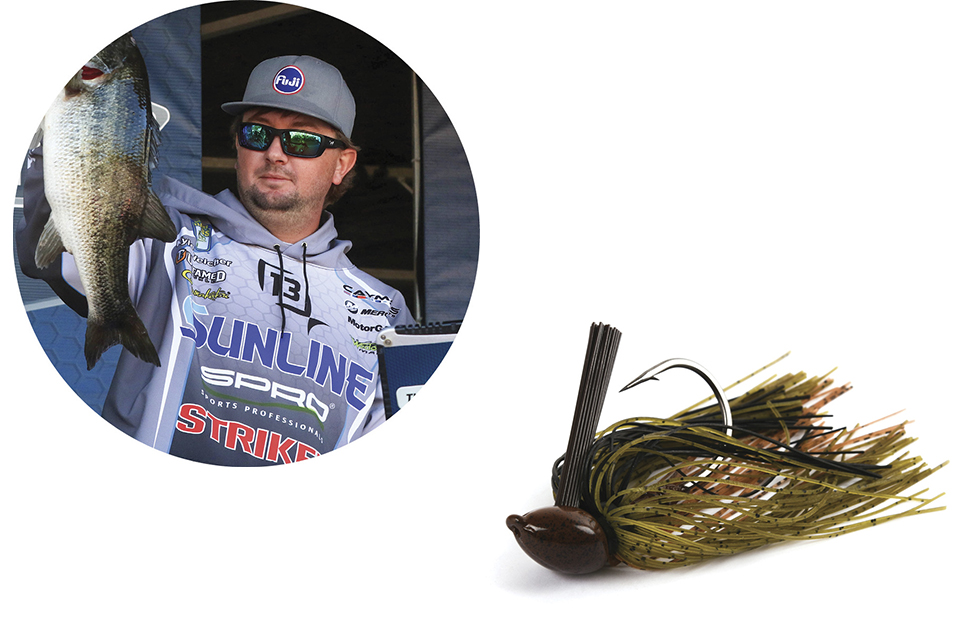
WHY: Size matters
WHERE: Heavy cover
Kyle Welcher – Highland Reservoir
Infiltrating the food source is Welcher’s strategy for picking off postspawners. Shad spawns can come into play, but he’s more interested in the bream bed pattern, as the ones that target big panfish generally push the upper end of the lake’s upper size potential.
Welcher’s weapon of choice is a 1/2-ounce green pumpkin Untamed Tackle Ace Jig with a 13 Fishing Lunch Bug craw. Size matters, he said, and any fish that seriously considers eating this bait is a fish worth catching.
“It’s a big package because 90% of them are done spawning and they’re trying to feed back up,” Welcher said. “On highland reservoirs, the bream will bed from June to September, and that’s when I want to upsize my bait and get something that will attract those fish that are feeding on bluegill and make them react to that bait.”
Proximity is key for Welcher, as he’s looking for the most reliable scenario possible. What that means is getting close enough to spot and engage sporadic wolf packs but also reach the nearby cover.
“I want to fish the heaviest cover closest to the bluegill beds,” Welcher said. “That could be docks, laydowns, bushes, debris mats — anything where those fish can hang out.
“I’ll target both, but those wolf-packing bass are inconsistent, whereas I know the ones that are always in that cover close to the bluegill beds are going to be more consistent. I’ll flip that jig directly to the bluegill beds or swim it over top, but I catch more big ones flipping it really close to cover.”
Noting that he values a fast fall in the typically clear highland waters, Welcher stresses repetition. This is no time for soaking; it’s a yes or it’s a no.
“It’s a game of numbers. You flip it in there and before it goes to the bottom, typically a fish has got it,” he said. “If it hits the bottom of whatever I’m flipping to, I might hop it twice and then I’m going to reel it in and make another presentation. I’m trying to flip to as many pieces of cover as I possibly can in a day.”
Welcher flips with a 7-6 heavy-fast 13 Fishing Envy Black rod and an 8.1 13 Fishing Inception reel with 22-pound Sunline fluorocarbon. The fish he’s after are there to eat and do not need finessing — you just have to get them out of that cover.
“Early in the morning, you can catch them on the bluegill beds and in the thick cover, but once that sun gets high, you can really pick up the speed and go even faster because it’s easier to know exactly where those fish are going to be. They’re going to be in the deepest, darkest, thickest cover when that sun is the highest.”
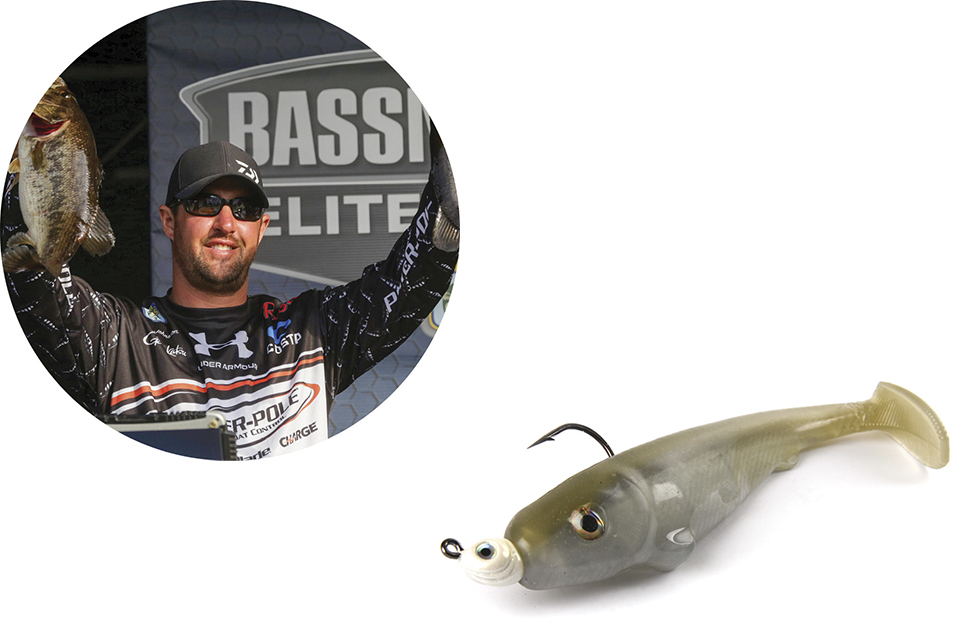
WHY: Big, easy meal
WHERE: Ledges that feature current
Cory Johnston – TVA Lake
Ledges are the obvious call for postspawners, and Johnston believes his best tool for tempting and hooking giants is a 6- to 8-inch Scottsboro swimbait in the hitch or ayu color. He’ll rig the bait on a homemade 3/4- to 1-ounce swimbait head with a 5/0 to 8/0 hook and fish it over rock or grass bottom with toad-friendly features.
“Definitely, on the Tennessee River, you want something that the current’s hitting, whether it be a point [or] a little bump out on the ledge,” Johnston said. “There has to be something different on the ledge, whether it’s a spot where the current swings around it or there’s a rockpile or brushpile down there.”
Keeping his distance and making long casts, Johnston typically throws his bait on 20-pound Seaguar Tatsu fluorocarbon, but if he’s having trouble keeping the bait down, he’ll drop to 15-pound test. He likes a 7-6 Daiwa Tatula Elite flipping stick for heavier line or a 7-4 Daiwa Tatula Elite frog rod for lighter fluoro.
With both, a 7.1 reel is just right for the creeping retrieve that tickles the bottom and just keeps the tail moving. That gear ratio also provides sufficient speed to quickly gather line and keep the casts rolling.
Johnston typically rotates through a milk run of key spots and gives each one multiple chances to fire. Increased current strength often is the catalyst, but the stiffer flow also limits his mobility.
“In lighter current, I’ll fish a spot from multiple angles if the bite slows down,” Johnston said. “The stronger the current, the better the feeding, but you’re generally limited in your casting angles.”
Johnston’s keys to fooling giants: Take time to rig the swimbait straight. Sloppy rigging pulls the bait and mars the presentation. Also, the faster you reel, the more the bait rises in the current.
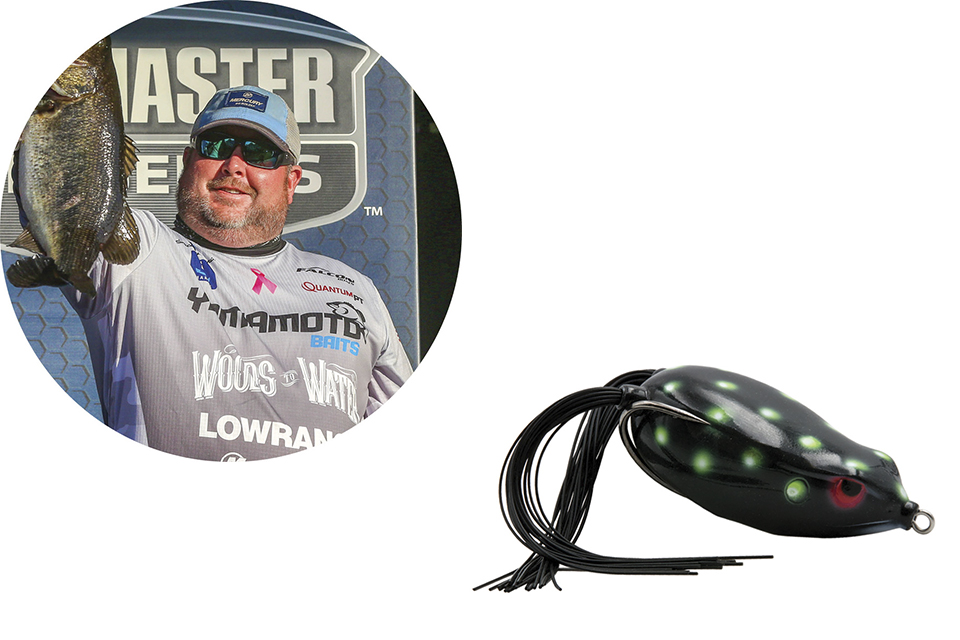
WHY: Goes anywhere
WHERE: Isolated thick stuff, like pads
Jacob Powroznik – Tidal Fishery
In his James River home waters and anywhere ebb and flow washes through shallow vegetation, Powroznik puts his big-bite trust in a topwater frog. June finds the fish done with their spawn, so targeting lily pads, marsh banks and hydrilla often puts his bait in front of railed-out fish looking to fill out their diminished figures.
The frog’s go-anywhere design makes it a good bet throughout the tide. Powroznik expects the fish to invade the flats on higher water and drop to the edges as it falls. His ideal window is the first hour of the incoming tide, as expanding opportunity ignites a ravenous bite.
“I throw the Livingston Freddy B; it’s a little larger than most, and it moves a little more water,” Powroznik said. “A lot of times, we just have pad clusters about the size of a bass boat. These isolated spots are where some of the biggest bass I catch that time of year come from.
“You want to fish where a lot of people aren’t going to be able to throw their bait, or you want to fish on spots people aren’t targeting as much. For example, you know the average person can’t sling their frog under a dock where there’s a little cluster of pads, or under a cypress tree — something out of the ordinary.”
Powroznik likes a white frog for dimmer days, black for all-around duty and a brown with an orange belly when bluegill abound. Turning the fish and separating it from the cover is critical, so Powroznik throws his frog on a 7-4 Quantum Smoke baitcasting outfit with 65-pound braid.
Partly cloudy days typically deliver the best action, as the fish aren’t hiding from intense sunlight but feeding comfortably with just enough visibility. For maximum appeal, Powroznik stresses the importance of adjusting frog presentations as the day unfolds.
“First thing in the morning, I’ll probably be working it pretty slowly because the sun hasn’t gotten up yet,” he said. “You’re barely walking it through that cover; let the fish get a good feel for [the bait]. They probably do see the bait, but for the most part, they feel it and then they’ll home in on it.”
As sunlight increases and shadows shrink, Powroznik steps on the gas until he works his frog into that key area where he suspects a big fish will hide. He’ll pepper the sweet spots with casts and slowly walk his bait through the area.
“A lot of times, that will trigger one of those big ones to bite.”
Whether you are fishing a river, tidal fishery or impoundment, fill your tacklebox with the baits recommended by these big bass experts and take to heart the patterns mentioned here. June giants can be caught if you have the right tools and mindset.
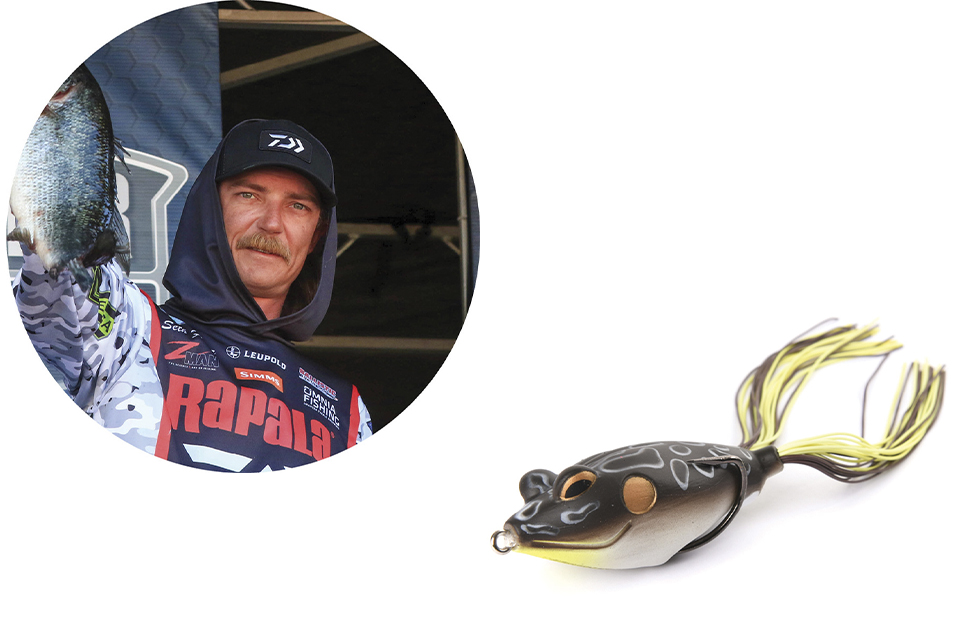
WHY: Allows for slow presentation and is easy for bass to track in thick cover
WHERE: Duckweed mats
Seth Feider – Grassy River
For the upper Mississippi and similar weedy river runs, Feider’s philosophy is simple: Less is more. Specifically, he wants to find small, isolated patches of floating duckweed positioned between the spawning pockets and the main river.
“There’s not going to be a ton of duckweed that time of year, but what there is gives them good cover, and it’s about the best thing on planet Earth to throw a frog in,” Feider said of the yielding vegetation. “If I’m looking for a big fish, it’s going to be [in] the only patch of duckweed within a quarter- to a half-mile.
“Duckweed makes a really thin mat and they feel protected, but it’s not like a Florida mat where you need an ounce weight to get through. There’s not a lot stopping them from getting your frog.”
Targeting these spots with a Terminator Walking Frog, Feider said there’s always a laydown or a patch of rooted grass holding the transient duckweed. The additional habitat elements don’t hurt, but he finds the right balance of current essential.
“Everything in [the river fish’s] lives are determined by current,” Feider said. “The less current you have, the closer they’ll be to the main river; the more current, the farther back they’ll be in the tributaries off the tributaries.”
With most of his spots the size of a truck hood, Feider fares best with specific casts and a slower cadence. He’s not trying to cover a lot of water, as the strike zone is small and immediate.
“Most of your bites are going to come in the first four twitches of your frog,” Feider said. “If I’m looking for a big fish, it’s not somewhere I’m going to pole down and make 100 casts in every direction. It’ll be two or three casts, at best.”
Feider’s standard frog setup comprises a 7-0 medium-heavy rod, 40-pound braid and an 8.1 reel for rapid recovery and casting efficiency. As he explained, higher gear ratio reels tend to sacrifice power, so Feider uses a reel with oversized handles for maximum reeling torque.
Originally appeared in Bassmaster Magazine 2022.





